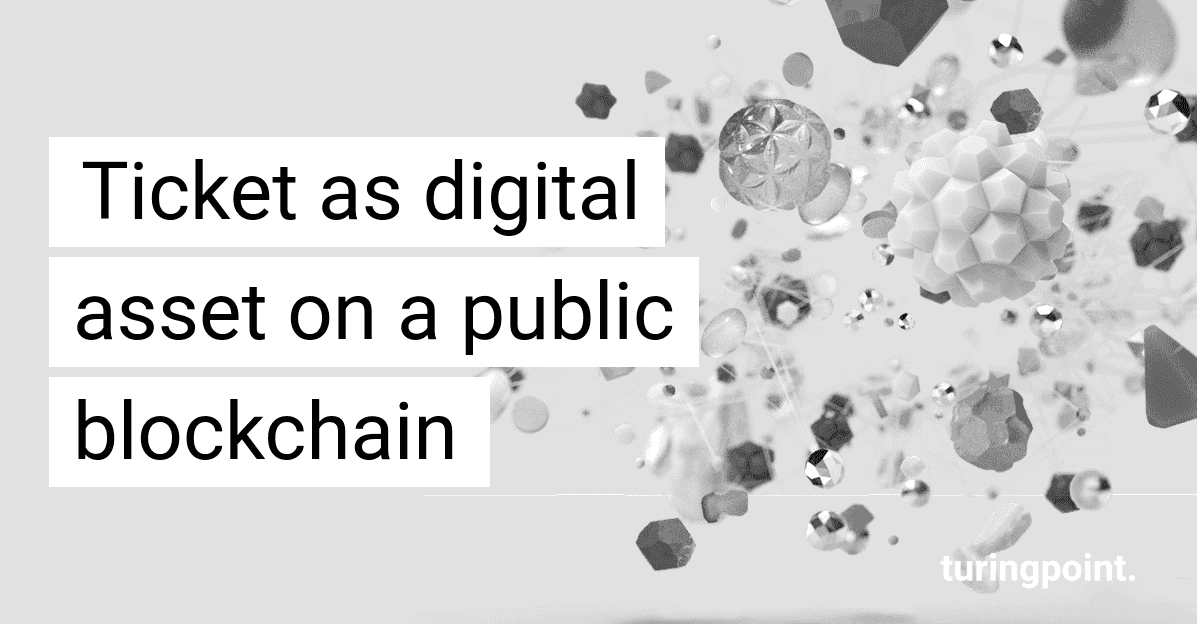Ticket as a digital Asset on a public Blockchain
Digital assets are goods or rights that people can buy or earn in digital form. Tickets can be displayed as such immaterial value.

Table of content
Digital asset
Digital assets are goods or rights that people can buy or earn in digital form. They can be pegged to physical assets as Security Token Offerings do. More interesting are assets that exist only immaterially like in-game items, tickets or the tokenization of a Digital Rights Management. These Assets have no physical custody risk and it revolutionizes the way these assets are owned, managed, stored and transferred.
Ticket as a digital asset
Tickets are complex and shortlived digital Assets. All this can be represented in digital form with decentralized rules in a so-called smart contract. Thus, every asset needs its individualized rules which are defined at the issuance by the issuer.
Business problem
In the ticketing industry, the original economic participants in the sale of a ticket (usually the venue, artist, team, or promoter) often don’t directly benefit when their tickets are resold. As a result, they charge as much as they can upfront – through VIP packages, high priced premium tickets, and high fees – knowing those ticket resellers will make a fortune on the secondary market by charging as much as 25% of the resale price split between buyer and seller.
Unlike the manufacturers of the physical things we own, the issuers of digital assets often try to create and enforce rules governing what we can and can’t do with the digital assets we own. For example, sometimes issuers don’t want us to be able to easily transfer or resell the assets they create. And when reselling is permitted, the user experience is often terrible and/or the fees that are charged are exorbitant.
What if there was a way to design a digital assets ecosystem that works better for both issuers and consumers? An ecosystem that enables issuers to create rulesets around their digital assets and trust that they will be enforced without creating walled gardens? And an ecosystem that makes it much easier for consumers to transfer or sell their digital assets while respecting the rules set by the issuer?
Advantages through an open and public blockchain protocol
- Visitors can keep their stuff forever
- Control over the secondary market due to programmable rules like price caps or resellers
- Increased efficiency in handly high demands in one platform
- proof of ownership: Verify existence and ownership against third parties on the blockchain
Public versus permissioned blockchain
Permissioned blockchain consortiums don’t offer trust against the public because an individual can’t verify transactions through its node either nor participate in the consensus mechanism. These architectures are only in local interest only like B2B processes. Some users are satisfied with this level of trust in the consortium with common interests.
| Permissioned | Public | |
|---|---|---|
| Access | invite only | anyone |
| Consensus | method agreed between participants | incentive structured |
| Currency | optional | required |
| Tradable | optional | yes |
| Examples | Hyperledger, R3 Corda | Bitcoin, Ethereum, Monero |
Permissioned blockchain with e.g. Blockstreams Liquid
The Liquid Network is operated by its members - large exchanges and financial institutions that benefit from its use. Blockstream has no control of the network and serves only as a technology provider. With no single entity in control, there is no longer any single point of failure.
Permissioned blockchains use an approach to consensus called Strong Federations. A Strong Federation removes the need for costly Proof of Work mechanisms and replaces it with the collective actions of a group of mutually distrusting participants.
Using a public blockchain through Tari
Most public blockchains deliver insecure or centralized consensus mechanisms or aren’t immutable. Monero is one of the most secure and decentralized cryptocurrencies in the world. Tari is being architected as a merge-mined sidechain of Moneros public blockchain and will inherit its foundational security model.
The sidechain will use the Mimblewimble technology and will be written in Rust which leads to great performance. Mimblewimbles offer strong privacy by default aswell.
Tari defined by themselves
Tari will become this new digital assets ecosystem. With Tari, creators of digital assets will be able to issue them as programmable non-fungible tokens on the Tari blockchain and trust that their rules will be enforced. Consumers will be able to use applications built on top of the Tari blockchain to more easily transfer their digital assets while respecting the rules set by issuers. Ultimately, our intended result is a more frictionless, lower cost digital asset ecosystem that
benefits all constituents.
Sources
Tari: Advancing Monero Through Ecosystem Development
Tari Labs, „Tari - Digital assets focused blockchain protocol“, Sunday, Jul 14, 2019, Tari
Blockstream Corporation Inc., „Liquid by Blockstream“, Sunday, Jul 14, 2019, Liquid
Contact
Curious? Convinced? Interested?
Schedule a no-obligation initial consultation with one of our sales representatives. Use the following link to select an appointment:
